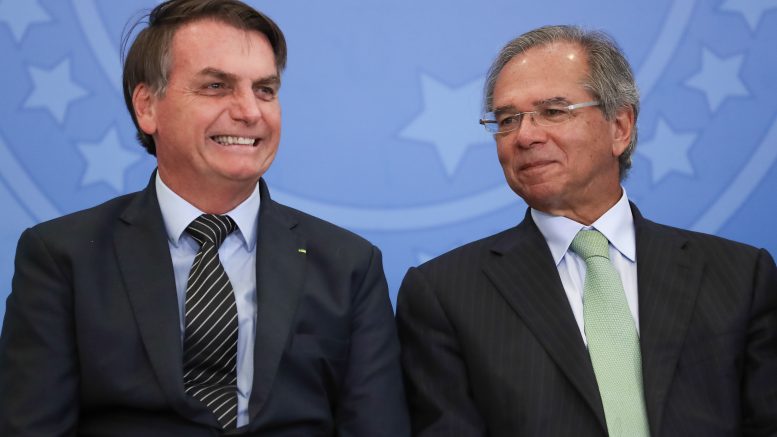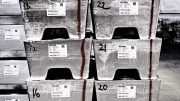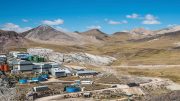South American countries have taken varying approaches to containing the spread of COVID-19, ranging from leaving it to states and cities to handle the virus to implementing aggressive lockdowns and curfews that have forced mining companies to reduce or shutter their operations.
While all have moved in recent weeks to deal with the disease, some countries are seeing more success than others.
Argentina has already started to bend its curve thanks to early and aggressive shutdown measures. The country, which had its first confirmed case in early March, first closed its borders and suspended schools on March 15. Four days later, centre-leftist President Alberto Fernández implemented a mandatory lockdown from March 20 until March 31, with police enforcing it on the streets. The measure was extended twice, and is currently in place until April 26.
On April 10, Fernández shared slides that indicated the measures were working, comparing Argentina’s 1,975 confirmed cases at the time and modest curve to Brazil’s 19,638 cases and precipitously steep climb. He also noted that if Argentina hadn’t implemented quarantine measures, it was projected to have had 45,044 cases by that day, with 83% of its intensive care beds occupied. Instead, just 3.9% of the country’s ICU beds are in use.
To combat the economic toll of the virus on Argentina’s already fragile economy, Fernández rolled out an economic and social relief package that will invest as much as 2% of the country’s GDP — including 10,000-peso (US$150) payments for almost eight million Argentinians — and issued an executive order preventing cuts to any essential services for retirees, social welfare recipients and low-income households.
While Fernández put mining on the list of essential sectors, many lithium miners in the country have cut back or stalled their operations. McEwen Mining (TSX: MUX; NYSE: MUX) also halted its 49%-owned San José mine and Los Azules copper project until further notice.

A hiker at McEwen Mining’s Los Azules advanced-stage porphyry copper project located in the cordilleran region of San Juan Province, Argentina near the border with Chile. Credit: McEwen Mining
In Peru, the government also moved swiftly after its first case on March 6. On March 15, President Martin Vizcarra implemented a country-wide lockdown for 15 days, which involved closing the borders, restricting travel within the country and a mandatory closure of all non-essential businesses. Constitutional rights including free movement and assembly were also suspended. The country has implemented a strict curfew, and has rules in place preventing more than one person per household from leaving home each week. The quarantine has been extended twice so far, and is currently in place until April 26. Vizcarra has said some measures likely can be lifted in May.
While the country has the second-highest confirmed case rate in South America — at 15,628 as of April 19 — that’s in part due to a massive ramp-up in testing. On April 14, Peru tested more than 15,000 people, in comparison to just 1,000 on the same day one week prior, according to Bloomberg.
“The Peruvian government is one of the ones that’s enacted the more restrictive measures against the pandemic,” Verónica Hurtado, a PhD candidate in the University of British Columbia’s department of political science, who studies the impact of mining operations on local politics in Peru, told The Northern Miner.
Mining companies are allowed to carry out critical operations, including transporting mineral concentrates and other goods, while adhering to new safety, health and environmental conditions. Many companies, including Pan American Silver (TSX: PAAS; NASDAQ: PAAS), Newmont (TSX: NGT; NYSE: NEM), Trevali Mining (TSX: TV), and Sierra Metals (TSX: SMT; NYSE-AM: SMTS) reduced or shuttered their operations to comply with the state of emergency. On April 14, BHP (NYSE: BHP; LSE: BHP) and Teck Resources (TSX: TCK.B; NYSE: TECK) announced production would be suspended at the Antamina copper mine for at least two weeks. The mine was exempted from the measures due to its remote location, but the extension of the shutdown resulted in the companies deciding to swap out their shift crew.
The Peruvian government has implemented rules that allow miners to come to work for 30 days, but only if they declare they don’t have symptoms of the virus and haven’t been in contact with someone who has it. “The problem is, it doesn’t require mines to test the workers,” Hurtado said. “It opens up this space for workers to be asymptomatic or lie because they just want to keep their jobs.”
UBC’s Hurtado said the virus is exacerbating existing tensions in small mining communities. “Although mines have the right to continue producing and provide a source of income to these workers, they are endangering the local communities where they usually operate. Moreover, you have a situation where they have been donating medical equipment and investing in health care for the communities, but [communities] still feel unsafe because of all the transitive [workers].”
In neighbouring Chile, which had its first known case of the virus in early March, the government closed the borders in mid-March, announced a 90-day “state of catastrophe” and implemented curfews, as well as quarantines in select districts in Santiago. Chile’s plans for a referendum on its constitution reforms, slated for April 26, were also postponed. Its confirmed cases as of April 19 sit at 10,088.
The country has the highest testing rate in South America at 2,900 tests per million people, according to data from Worldometers quoted by Bloomberg, while Chile’s mortality rate sits at 1.3%, based on confirmed cases and deaths as of April 20, in comparison to the World Health Organization’s global average of 6.8%. But some doctors in Chile told The Guardian newspaper on April 10 that it’s too early to say if the country is handling the crisis well because early cases were concentrated in rich neighbourhoods, where people had access to quality health care.
Meanwhile, the region’s largest countries, Mexico and Brazil, have stumbled in their responses.
Brazil has moved slowly to curb the spread of the virus, and, as of April 19, the country has the largest number of infections (38,654) and deaths (2,462) in South America. The country’s efforts have been impeded by President Jair Bolsonaro’s skepticism about the danger of the disease. While state governments closed non-essential businesses and implemented quarantine measures, Bolsonaro criticized the stringent measures, calling the virus a “small flu” and blamed media for scaring citizens. “In my particular case, because of my background as an athlete, I wouldn’t need to worry if I was infected by the virus,” Bolsonaro declared in a televised address on March 24, according to The Guardian’s reporter in Rio de Janeiro. “I wouldn’t feel anything or, at the very worst, it would be like a little flu or a bit of a cold.”
Bolsonaro also engaged in a war of words with his health minister, Luis Henrique Mandetta, over how the virus should be handled, with the latter encouraging Brazilians to practice social distancing. Bolsonaro fired Mandetta on April 16, and three days later the president joined anti-lockdown protestors who called for a military coup to end the lockdown measures.
In Mexico, which had its first confirmed case in late February, some schools suspended classes and sporting events were cancelled, but President Andrés Manuel López Obrador was still downplaying the risk of the virus in mid-March, saying that “pandemics … won’t do anything to us,” and accusing both the media and his political opponents of overstating the threat. States and cities were left to impose curfews and close gathering places such as bars, nightclubs, movie theatres and museums.

Agnico Eagle Mines’ Pinos Altos gold-silver mine in northern Mexico, 220 km west of Chihuahua. Credit: Agnico Eagle Mines.
López Obrador didn’t move to limit gatherings of more than 100 people until March 24, and declined to shut down non-essential businesses until April 1, prompting mining companies such as Agnico Eagle Mines (TSX: AEM; NYSE: AEM), Alamos Gold (TSX: AGI; NYSE: AGI), McEwen Mining and Newmont to put their operations in care and maintenance.
While Mexico only had 8,261 confirmed coronavirus cases as of April 19, Deputy Health Minister Hugo Lopez-Gatell said on April 16 the country could have as many as 55,951 people infected, according to Reuters.
Vanda Felbab-Brown, a senior fellow in the Centre for 21st Century Security and Intelligence in the foreign policy program at the Brookings Institution, noted in a late March commentary that López Obrador had followed “a dangerously dismissive and outright irresponsible attitude toward the coronavirus” as other populist leaders have worldwide — Bolsonaro in Brazil, Donald Trump in the U.S. and Imran Khan in Pakistan. All four countries have seen higher confirmed cases, delayed or no social distancing measures, and attempts to end them.
“[López Obrador’s] reluctance to acknowledge the seriousness of COVID-19 … resembled the dithering we’ve seen from Trump, Bolsonaro and Khan: it’s a misguided attempt to save the country’s faltering national economy,” Felbab-Brown wrote. “Like other leaders, AMLO has been trading people’s lives for the delusion that Mexico’s economy can be sheltered from the pandemic.”
As South American countries have moved to deal with the virus, base metals are expected to take a hit.
Production disruptions of copper mines in Peru, Chile, Mexico and Canada will remove 1.3% of global supply, said Scotiabank commodity strategist Nicky Shiels in an April market insights report. Shiels also noted that “new risks emerge daily,” including Panama ordering First Quantum Minerals (TSX: FM) to shutter its copper mine temporarily to prevent the spread.
Natalie Scott Gray, a London-based senior metals analyst at INTL FCStone, told The Northern Miner in an email on April 20 that, at present, 425,000 tonnes of copper production has been taken offline, with Central and South America responsible for 120,000 tonnes of that, or 28%. Peru was the hardest hit, with 85,000 tonnes of production lost, followed by Panama at 14,000 tonnes, Chile at 13,000 tonnes and Ecuador at 7,000 tonnes.
Scott Gray also noted that supply-side disruptions won’t be enough to offset the substantial drop in demand across all base metals in 2020, with each of them forecast to record surpluses this year.
“It is worth keeping in mind here that any continuation of disruption to supply will ultimately also be playing out as disruption to demand, which was initially and immediately impacted as the virus fast spread in China,” she said. “We believe that the longer-term focus for the supply side will ultimately come down to the impact that lower metal prices and lower demand will have on future investment, with a strong theme appearing that not only are mining majors announcing a reduction to capex levels for 2020, but future projects are being suspended indefinitely.”
Global growth is set to halve in 2020 from pre-coronavirus levels and that spells trouble for base metal demand, the ultimate driver of future prices, Scott Gray said. “The longer-term and more influential issues on supply arises from the price points of these metals, rather than how long supply disruption will last.”






Be the first to comment on "South America divided on coronavirus measures"